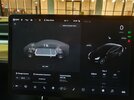The car was magnificent on the road. I enjoyed the frequent stops and slower pace. I do not have the words to describe Autopilot on the open road or in congested traffic. I found the car very comfortable. My longest daily travel was in the 12-hour range.
Background - I had never supercharged previously, had range anxiety, had supercharger availability anxiety. I was skeptical about everything. I laid out a non-aggressive itinerary. I bought a blank notebook to jot down data at every charge along the way. I was recording mileage, ambient temp, battery percentage, average speed, etc. The night before I charged up to 100%. I had no trust so I used the strategy of never passing up a supercharger and filling up to 90%. I navigated from supercharger to supercharger. I did not deviate from this strategy from NOLA to Denver. In the moderate climates, the range of an SC -> SC trip matched what was projected. As the air temp dropped and the wind picked up I did experience up to a 10% loss in predicted battery level (range). The best trick that I learned was to find an 18 wheeler that was traveling the desired speed and let autopilot draft behind the truck.
What I found: I never had to wait for a charge. A few SC's were broken. Some were in wonderful locations, others were in dreadful locations. I like superchargers. Telsa people mostly keep to themselves. Tesla people like to be buried in their smartphones.
On the way home, Since the biggest variation in percentage I had experienced was 10%, I decided to charge up to a level where I would arrive at my next SC with a 20% predicted charge (10% error, and 10% safety). When I got out of the colder temps, I reduced this to 15%. I also started trusting the car to skip superchargers if possible.
My question is what strategy do you employ to charge up with the least amount of time (energy) and have extra juice in the battery as a safety factor, when you are traveling from SC -> SC? What is your safety factor? Do you top off the night before or the morning of?



